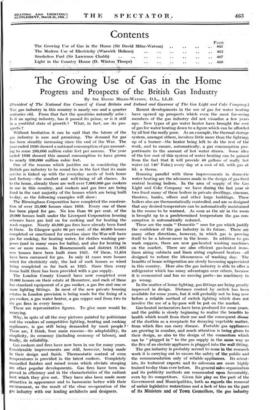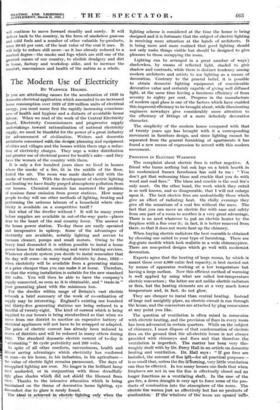The Growing Use of Gas in the Home
Progress and Prospects of the British Gas Industry
By SIR DAVID MILNE-WATSON, D.L., LLD.
(President of The National Gas Council of Great Britain and Ireland and Governor of The Gas Light and Coke Company.) TILE gas industry in this country is nearly, one and a quarter centuries old. From that fact the questions naturally arise : Is it an ageing industry, has it passed its prime, or is it still in a youthful state of growth ? What, in fact, are its pro- spects ?
Without hesitation it can be said that the future . of the gas industry is sure and promising. The demand for gas has been steadily increasing since the end of the War. The year ended 1920 showed a national consumption of gas amount- ing to some 260,000 million cubic feet per annum. The year ended 1930 showed this annual consumption to have grown to nearly 330,000 million cubic feet.
One of the reasons which justifies me in considering the British gas industry to be sound lies in the fact that its main service is linked up with the everyday needs of both home :and factory—the comfort and well-being of all classes. As to the home, already there are well over 7,000,000 gas cookers in use in this country, and cookers and gas fires are being .fixed in the vast majority of the houses which are being built to-day, as the following examples will show: The Birmingham Corporation have completed the construc- tion of over 33,000 houses since '1919. Every one of these has been piped for gas. No less than 99 per cent. of the .20,000 houses built under the Liverpool Corporation housing schemes have gas laid on for cooking and for heating the wash copper. Nearly 40,000 gas fires have already been fixed in them. In Glasgow quite 96 per cent. of the 40,000 houses completed or sanctioned for erection since the War will have gas for cooking, for heating water, for clothes washing pur- poses (and in many cases for baths), and also for heating in one or more rooms. In Bournemouth and district 11,895 new houses have been built since 1921. Of these, 11,854 hae been carcassed for gas. In only 41 cases were houses wired for electricity only, the last of such houses so wired being completed so far back as 1925. Since then every house built there has been provided with a gas supply.
The LondOn County Council have now completed over 19,000 houses on their estate at Becontree, and each of these has standard equipment of a gas cooker, a gas fire a'nd one or more lighting fittings. In most of the new private housing estates in London provision is being made for the fixing of a gas cooker, a gas water heater, a gas. copper and from two to six gas fires in every house.
These are representative figures. To 'give, more would be wearying.
Why, in spite of all the.rosy pictures painted by politicians and the vendors of competitive lighting, heating and cooking appliances, is gas still being demanded by -most. people ? There are, I think, four main reasons—its adaptability, its simplicity, its economy (including economy of labour), and finally, its reliability.
Gas cookers and fires have now been in use for many years. Considerable improvements are still, howeVer; being made in their design and finish. Thermostatic control of oven temperatures is provided in the latest cookers. • Completely enamelled finishes and raised ovens which obviate stooping are other popular developments. Gas fires have been im- proved in efficiency and in the characteiisti-cS of the radiant heat which they give out. They have also been made more attractive in appearance and to harmonize better with their environment, as the result of the close co-operation of the Ps industry with our leading architects and designers. Recent developments in the use of gas for water heating have opened up prospects which even the most far-seeing members of the gas industry did not visualize a few years ago. New types of gas water heater have brought the cost of gas for water heating down to a figure which can be afforded by all but the really poor. As an example, the thermal storage system, amongst others, involves little more than the lightingr up of a burner—the heater being left to do the rest of the work, and to ensure, automatically, a gas consumption pro- portionate to the amount of hot water drawn. Sonic idea of the low cost of this system of water heating can be gained from the fact that it will provide 40 gallons of really hot water (at 140° Fahr.) every day at a cost of 6d. with gas at 8d. a therm.
Running parallel with these improvements in domestic water heating are the advances made in the design of gas-fired central heating boilers. In the area of supply of the Gas Light and Coke Company we have during the last year or two fixed many of these boilers in private dwellings, cinemas, theatres, banks, offices and other large buildings. These boilers also are thermostatically controlled, and are so designed that any desired temperature can be automatically maintained in the rooms to be warmed. As soon as the air in the room is brought Op to a predetermined temperature the gas coli- sumption is automatically reduced.
These are the main " Domestic " uses for gas which justify the confidence of the gas industry in its future. There are many other directions, however, in which gas is proving itself to be a labour-saver in the home. In addition to gas wash coppers, there are now gas-heated washing machines on the market. There are also efficient gas-heated irons, linen airing cabinets and linen airing cupboard heaters—all designed to reduce the irksomeness of washing day. The benefits of home refrigeration arc slowly becoming appreciated in this country. Here also the gas industry is able to offer a refrigerator which has many advantages over others, because it is economical and has no moving parts—no machinery to go wrong.
In the matter of home lighting, gas fittings are being greatly improved in design. Distance control by switch has been available for some years, but it will probably not be long now before a reliable method of switch lighting which does not involve the use of a by-pass will be put on the market.
Gas-heated incinerators have .been produced for some years, and the public is slowly beginning to realize the benefits to health which result from their use and the consequent disuse of the dustbin as a receptacle for decaying vegetable matter, from which flies can tarry disease. Portable gas appliances are growing in number, and much attention is being given to their design, as also to the design of the connectors which can be " plugged in " to the gas supply in the same way as the flex of an electric appliance is plugged into the wall fitting.
The gas industry is probably second to none in the research work it is carrying out to ensure the safety of the public and the recommendation only of reliable appliances. Its scient- ists, its technical experts and its salesmen are more highly trained to-day than ever before. Its general sales organization and its publicity methods are commented upon favourably, even by its competitors. Given fair play on the part of the Government and Municipalities, both as regards the removal of unfair legislative restrictions and a lack of bias on the part of its Ministers and of Town Cotmeillors, the gas industry will continue to move forward steadily and surely. It will deliver back to the country, in the form of smokeless gaseous and solid fuels and a number of other valuable by-products, some 80-85 per cent. of the heat value of the coal it uses. It will help to reduce still more—as it has already reduced to a marked degree—the smoke and fogs which are-still one of the greatest curses of our country, to abolish drudgery and dirt in home, factory and workshop alike, and to increase the comfort, convenience and health of the nation as a whole.



















































 Previous page
Previous page